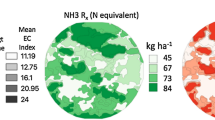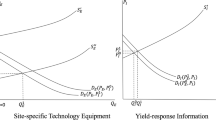Abstract
Site-specific fertiliser management has been discussed as an information-based farming concept that uses plant- and soil-specific information. However, agricultural practice has shown that, because of limited profitability , the adoption of site-specific fertiliser management often does not meet expectations. This chapter describes a framework for the economic assessment of site-specific fertiliser application and harvest management, provides an overview of selected studies and shows the future perspective of the technologies.
We concluded that precision farming technologies that aim to identify the economically optimal input rate (e.g. site-specific fertiliser application) often fail to provide considerable economic advantages for the farmer. This phenomenon can be explained by flat payoff functions, which are relevant for many agricultural production processes. Economically more promising from a theoretical point of view are precision farming approaches that enable higher product prices by achieving specific product qualities (e.g. site-specific harvest management). However, available studies currently do not provide empirical support for this theoretical conclusion.
Access this chapter
Tax calculation will be finalised at checkout
Purchases are for personal use only
Similar content being viewed by others
References
Bachmaier M, Gandorfer M (2009) A conceptual framework for judging the precision agriculture hypothesis with regard to site-specific nitrogen application. Precis Agric 10(2):95–110
Bongiovanni R, Lowenberg-DeBoer J (2004) Precision agriculture and sustainability. Precis Agric 5(4):359–387
Bullock DS, Lowenberg-DeBoer J, Swinton SM (2002) Adding value to spatially managed inputs by understanding site-specific yield response. Agric Econ 27(3):233–245
Diacono M, Rubino P, Montemurro F (2013) Precision nitrogen management of wheat. A review. Agron Sustain Dev 33(1):219–241
Gandorfer M, Rajsic P (2008) Modeling economic optimum nitrogen rates for winter wheat when inputs affect yield and output-price. Agric Econ Rev 9(2):54–64
Gandorfer M, Meyer-Aurich A, Heißenhuber A (2003) An economic assessment of site-specific and homogenous nitrate fertilization management in consideration of environmental restriction. Programme book of the joint conference of ECPA-ECPLF, Berlin, pp 407–408
Gandorfer M, Meyer-Aurich A, Kapfer M (2011) Ökonomische Aspekte von Precision Farming - aktueller Stand & Perspektiven. In: Hambrusch J, Larcher M, Oedl-Wieser T (Hrsg) Jahrbuch der Österreichischen Gesellschaft für Agrarökonomie, Band 20(2):35–44
Griffin TW, Lowenberg-DeBoer J, Lambert DM, Peone J, Payne T, Daberkow SG (2004) Adoption, Profitability, and Making Better Use of Precision Farming Data, Staff Paper #04–06. Department of Agricultural Economics, Purdue University, USA, West Lafayette
Khanna M, Epouhe OF, Hornbaker R (1999) Site-specific crop management: adoption patterns and incentives. Rev Agric Econ 21(2):455–472
Lambert DM, Lowenberg-DeBoer J (2000) Precision agriculture profitability review. West Lafayette, Site Specific Management Center, School of Agriculture, Purdue University. Available at: https://www.agriculture.purdue.edu/ssmc/FRames/newsoils.doc. Accessed 09 Sept 2016
Landesanstalt für Landwirtschaft (LfL) (2016) Deckungsbeiträge und Kalkulationsdaten. Bayerische Landesanstalt für Landwirtschaft. München. Available at: https://www.stmelf.bayern.de/idb. Accessed 24 Aug 2016
Lawes RA, Robertson MJ (2011) Whole farm implications on the application of variable rate technology to every cropped field. Field Crop Res 124(2):142–148
Liu Y, Swinton SM, Miller NR (2006) Is site-specific yield response consistent over time? Does it pay? Am J Agric Econ 88(2):471–483
Lowenberg-DeBoer J (1999) Risk management potential of precision farming technologies. J Agric Appl Econ 31(2):275–285
Martin CT, McCallum JD, Long D (2013) A web-based calculator for estimating the profit potential of grain segregation by protein concentration. Agron J 105(3):721–726
Meyer-Aurich A, Gandorfer M, Heißenhuber A (2008) Economic analysis of precision farming technologies at the farm level: two German case studies. In: Castalonge OW (ed) Agricultural systems: economics, technology, and diversity. Nova Science Publishers, Hauppage, pp 67–76
Meyer-Aurich A, Griffin TW, Herbst R, Giebel A, Muhammad N (2010a) Spatial econometric analysis of a field-scale site-specific nitrogen fertilizer experiment on wheat (Triticum aestuvum L.) yield and quality. Comput Electron Agric 74(1):73–79
Meyer-Aurich A, Weersink A, Gandorfer M, Wagner P (2010b) Optimal site-specific fertilization and harvesting strategies with respect to crop yield and quality response to nitrogen. Agric Syst 103(7):478–485
Oleson JE, Sorensen P, Thomson IK, Erikson J, Thomsen AG, Berntsen J (2004) Integrated Nitrogen input systems in Denmark. In: Mosier AR, Syers JK, Freney JR (eds) Agriculture and the nitrogen cycle. Island Press, Washington, DC/Covelo/London, pp 129–140
Organisation for Economic Co-operation and Development (OECD) (2016) Farm management practices to foster green growth, OECD Green Growth Studies. OECD Publishing, Paris. Available at: https://doi.org/10.1787/9789264238657-en Accessed 09 Sept 2016
Pannell DJ (2006) Flat earth economics: the far-reaching consequences of flat payoff functions in economic decision making. Rev Agric Econ 28(4):553–566
Reichardt M, Jürgens C, Klöble U, Hüter J, Moser K (2009) Dissemination of precision farming in Germany: acceptance, adoption, obstacles, knowledge transfer and training activities. Precis Agric 10(6):525–545
Robertson M, Llewellyn R, Mandel R, Lawes R, Bramley R, Swift L, Metz N, O’Callaghan C (2012) Adoption of variable rate fertiliser application in the Australian grains industry: status, issues and prospects. Precis Agric 13(2):181–199
Rogers A, Ancev T, Whelan B (2016) Flat earth economics and site-specific crop management: how flat is flat? Precis Agric 17(1):108–120
Schneider M, Wagner P (2008) Ökonomische Effekte der teilflächenspezifischen Bewirtschaftung auf betrieblicher Ebene. In: Werner A, Dreger F, Schwarz J. Informationsgeleitete Pflanzenproduktion mit Precision Farming als zentrale inhaltliche und technische Voraussetzung für eine nachhaltige Entwicklung der landwirtschaftlichen Landnutzung – preagro II. Available at: http://preagro.auf.uni-rostock.de/Veroeff/preagro_Abschlussbericht_2008.pdf. Accessed 25 Aug 2016
Silva CB, Do Vale SMLR, Pinto FAC, Müller CAS, Moura AD (2007) The economic feasibility of precision agriculture in Mato Grosso do Sul State, Brazil: a case study. Precis Agric 8(6):255–265
Sivaraman E, Lyford CP, Brorsen BW (2002) A general framework for grain blending and segregation. J Agribusiness 20(2):155–161
Tozer PR (2009) Uncertainty and investment in precision agriculture – Is it worth the money? Agric Syst 100(1–3):80–87
Tozer PR, Isbister BJ (2007) Is it economically feasible to harvest by management zone? Precis Agric 8(3):151–159
Zarco-Tejada P, Hubbard N, Loidjani P (2014) Precision Agriculture: An Opportunity for EU Farmers – Potential Support with the CAP 2014–2020, Policy Department, Structural and Cohesion Policies, Agriculture and Rural Development, European Parliament. Available at: http://www.europarl.europa.eu/RegData/etudes/note/join/2014/529049/IPOL-AGRI_NT%282014%29529049_EN.pdf. Accessed 09 Sept 2016
Author information
Authors and Affiliations
Corresponding author
Editor information
Editors and Affiliations
Rights and permissions
Copyright information
© 2017 Springer International Publishing AG
About this chapter
Cite this chapter
Gandorfer, M., Meyer-Aurich, A. (2017). Economic Potential of Site-Specific Fertiliser Application and Harvest Management. In: Pedersen, S., Lind, K. (eds) Precision Agriculture: Technology and Economic Perspectives. Progress in Precision Agriculture. Springer, Cham. https://doi.org/10.1007/978-3-319-68715-5_3
Download citation
DOI: https://doi.org/10.1007/978-3-319-68715-5_3
Published:
Publisher Name: Springer, Cham
Print ISBN: 978-3-319-68713-1
Online ISBN: 978-3-319-68715-5
eBook Packages: Biomedical and Life SciencesBiomedical and Life Sciences (R0)




